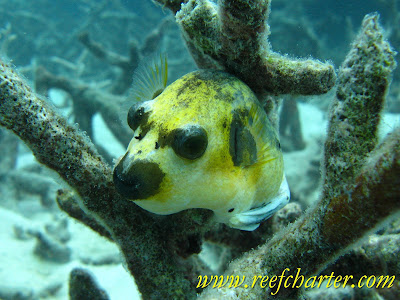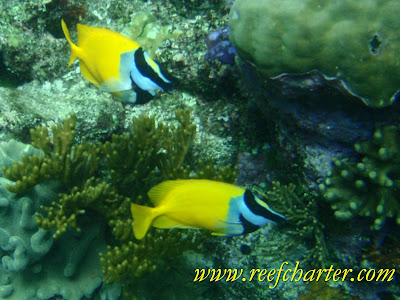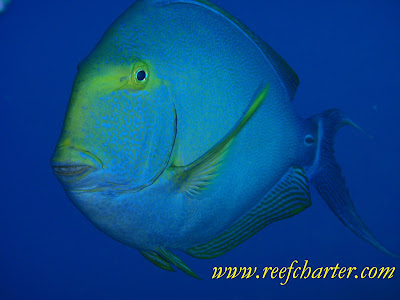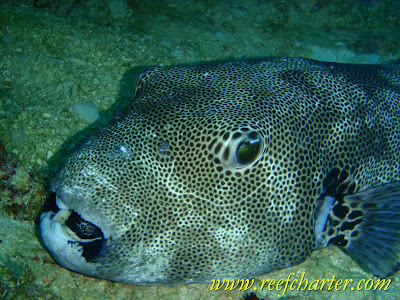The foxface or rabittfish was given it’s name from their small, rabbit-like mouths, large dark eyes, and a shy temperament.
The rabbitfish or foxface is an active algae eater on the Great Barrier Reef. They are often seen along with butterfly fish cleaning the coral and reef base. The Foxface grows to about 40cm (16″) long. Their bright and distinct colour bands make them very popular with aquarium owners, they are also relatively easly to keep in aquariums. Often vegetables are added to their diet while they are kept in aquariums.
Rabbitfish also have poisonous spines in their dorsal fins and will use them to protect themselves if they feel threatened. So do not touch or aggrevate these fish. They are also timid fish and will flee if at all possible so this is mainly an issue only in the aquarium environment.
Tag: Fish
Surgeon Fish – Species of the Reef
A colourful and common sight on the Great Barrier reef is the surgeon fish, like the yellow fin surgeon fish pictured above. The distinctive characteristic of the family is the spines, one or more on either side of the tail. Both the dorsal and tail fins are large, extending for most of the length of the body. The small mouths have a single row of teeth used for grazing on algae.
Surgeonfishes sometimes feed by themselves, but they are also often seen traveling and feeding in large colourful schools. It has been suggested that feeding in schools is a mechanism for overwhelming the highly aggressive defense responses of small territorial damselfishes that vigorously guard small patches of algae on coral reefs.
Most species are relatively small and have a maximum length of 15–40 cm (6–16 in), but some members of the genus Acanthurus, some members of the genus Prionurus, and most members of the genus Naso can grow larger, with the whitemargin unicornfish (N. annulatus), the largest species in the family, reaching a length of up to a meter (3,3 ft). These fishes can grow quickly in aquariums so it is advisable to check the average growth size and suitability before adding to a marine aquarium.
The Barracuda – Fish Species of the Reef
Very popular with scuba divers on our trips to the outer Great Barrier Reef, barracuda are an impressive sight on the reef. The fearsome looking barracuda has a reputation for being and aggressive fish but it is mostly undeserved. They really use their incredible speed to shock and attack its victims of smaller fish. They do not see humans as a meal or as a threat unless actively provoked. They have been known to get aggressive where potential food is involved, another good reason not to feed the fish or support operators that feed fish.
They are often seen in large groups in the early morning or late afternoon hanging around at the back of the reefs. What are groups of barracuda called? Batteries. The can grow to about 1.6 metres or just over 5ft, the guys in the photo above are just over a metre each. They have a large swim bladder (gas filled bladder) they use to control their buoyancy in the water. This allows them to hover perfectly for long periods of time with very little use of energy.
The Pufferfish – Species of the Reef

This fish has an obvious relation to it’s name and behaviour. It defends itself by inflating itself and forming a balloon by sucking in large amounts of water or air. It is not good to make them inflate themselves for the amusement of divers or onlookers. It places large stresses on the puffer-fish.
Having owned a couple of them in an aquarium as well as seeing them in the ocean, they have a ton of personality. The funny swimming motion and friendly behaviour endear themselves to everyone almost immediately. Puffers are able to move their eyes independently, just to add something else to check out when spotting these fish. Many species can change the color or patterns of their skin to match their environments
Believe it or not there are 121 different type of puffer fish around the globe. It seems over inflating your ego seems to be a popular defence everywhere. You will find the most variation in species around tropical locations and the cooler and river locations tend to have only a one or a few species in each location. Most people break puffers into two main categories the standard puffer and porcupine which has spines that stand on end as the fish inflates itself.
They are not an agressive fish and defense is mainly based on the puffer action or by it’s flesh that contains a deadly toxin. Considered a delicacy, the meat has to prepared just right or you will feel the effects of this poison. But how could you eat this cute little fella in the first place?
.



